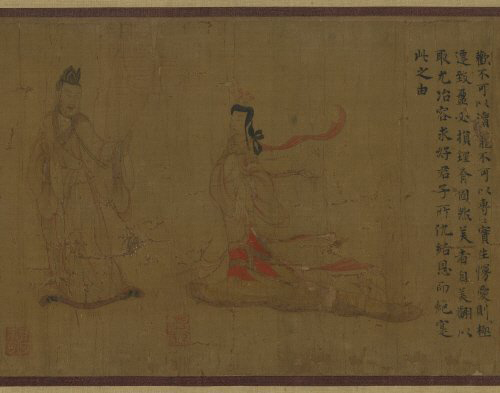Some of the great teachers of China appear to have had a similar view of the value of art to that held by Pope Gregory the Great. They thought of art as a means of reminding people of the great examples of virtue in the golden ages of the past.One of the earliest illustrated Chinese bookscrolls that have been preserved is a collection of great examples of virtuous ladies, written in the spirit of Confucius. It is said to go back to the painter Ku K'ai-chi, who lived in the fourth century AD.
中國有些偉大的賢哲對于藝術(shù)的價值觀似乎跟羅馬教皇格里高里所堅持的看法相似。他們把藝術(shù)看成一種工具,用以提醒人們回憶過去黃金盛世的美德典范。現(xiàn)存最早的中國畫卷有一卷是根據(jù)儒家思想選編的貞婦淑女事跡;據(jù)說原本出自公元4世紀(jì)的畫家顧愷之的手筆。
The illustration shows a husband unjustly accusing his wife, and it has all the dignity and grace we connect with Chinese art. It is as clear in its gestures and arrangement as one might expect from a picture which also aims at driving home a lesson. It shows, moreover, that the Chinese artist had mastered the difficult art of representing movement. There is nothing rigid in this early Chinese work, because the predilection for undulating lines imparts a sense of movement to the whole picture.
本頁面的附圖,畫著一個丈夫無端地責(zé)怪他的妻子,此畫卷具有我們所稱道的中國藝術(shù)的全部高貴和優(yōu)雅之處。畫中的姿勢和布置十分清楚,人們對一幅闡明事理的圖畫所可期待的能事已盡。此外,它也表明當(dāng)時的中國藝術(shù)家已經(jīng)掌握了表現(xiàn)運(yùn)動的復(fù)雜技藝。這幅中國早期作品中絲毫沒有生硬之處,因為畫中特別喜歡使用起伏的線條,這就賦予了整個畫面一種運(yùn)動感。












